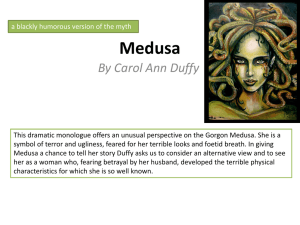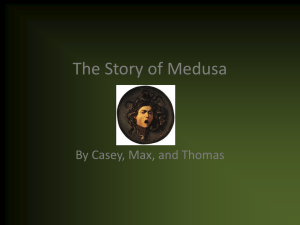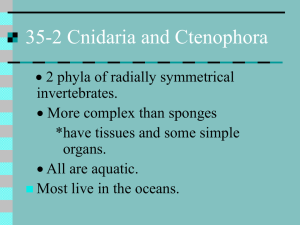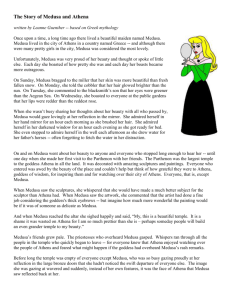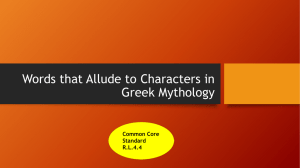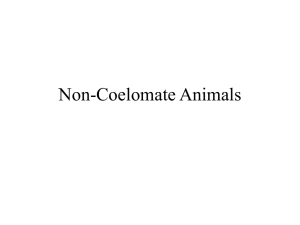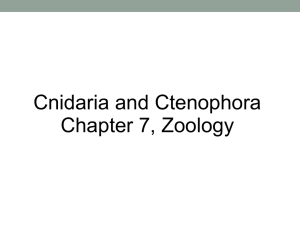View submission
advertisement
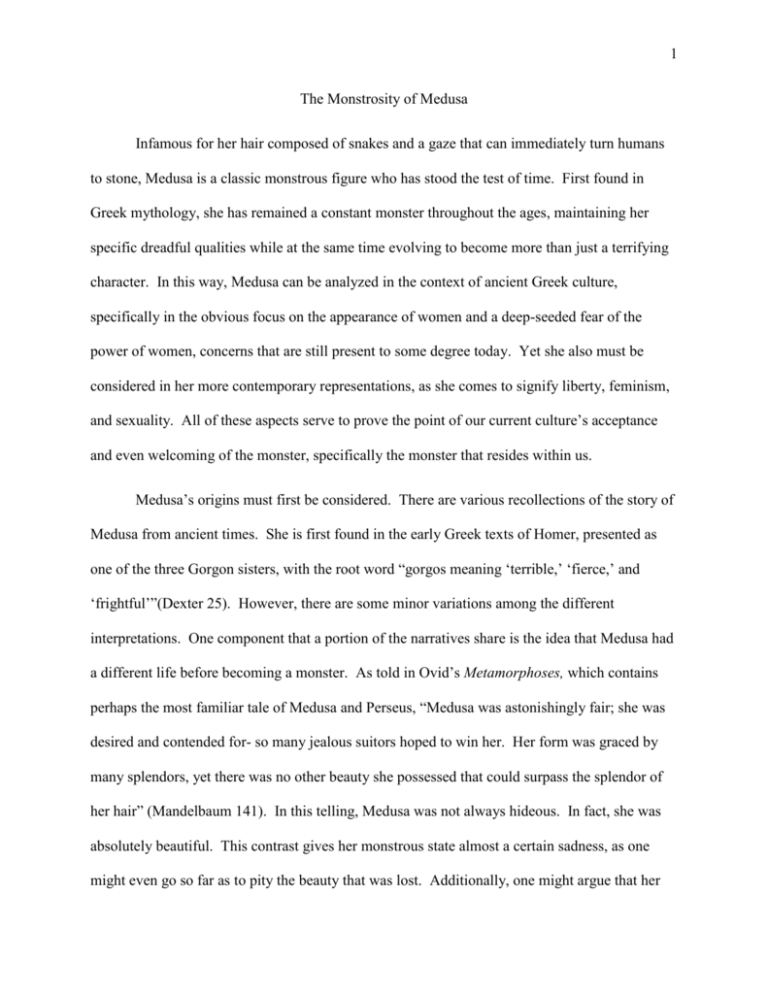
1 The Monstrosity of Medusa Infamous for her hair composed of snakes and a gaze that can immediately turn humans to stone, Medusa is a classic monstrous figure who has stood the test of time. First found in Greek mythology, she has remained a constant monster throughout the ages, maintaining her specific dreadful qualities while at the same time evolving to become more than just a terrifying character. In this way, Medusa can be analyzed in the context of ancient Greek culture, specifically in the obvious focus on the appearance of women and a deep-seeded fear of the power of women, concerns that are still present to some degree today. Yet she also must be considered in her more contemporary representations, as she comes to signify liberty, feminism, and sexuality. All of these aspects serve to prove the point of our current culture’s acceptance and even welcoming of the monster, specifically the monster that resides within us. Medusa’s origins must first be considered. There are various recollections of the story of Medusa from ancient times. She is first found in the early Greek texts of Homer, presented as one of the three Gorgon sisters, with the root word “gorgos meaning ‘terrible,’ ‘fierce,’ and ‘frightful’”(Dexter 25). However, there are some minor variations among the different interpretations. One component that a portion of the narratives share is the idea that Medusa had a different life before becoming a monster. As told in Ovid’s Metamorphoses, which contains perhaps the most familiar tale of Medusa and Perseus, “Medusa was astonishingly fair; she was desired and contended for- so many jealous suitors hoped to win her. Her form was graced by many splendors, yet there was no other beauty she possessed that could surpass the splendor of her hair” (Mandelbaum 141). In this telling, Medusa was not always hideous. In fact, she was absolutely beautiful. This contrast gives her monstrous state almost a certain sadness, as one might even go so far as to pity the beauty that was lost. Additionally, one might argue that her 2 monstrous qualities of anger and malice toward others stem from her resentment and bitterness over her change of state. In the physical description, the preoccupation with her lovely hair is obviously directly related to her later snaky hair, and so her most appealing attribute is transformed into her most hideous feature. The objectification of women is also evident in this idea, as Medusa is described only in terms of her physical appearance. The myth continues to explain that “her beauty led the Ruler of the Sea to rape her in Minerva’s sanctuary” and so Minerva “made Medusa pay: she changed that Gorgon’s hair to horrid snakes. And to this day, Minerva, to dismay and terrify her foes, wears on her breast the very snakes that she herself had set- as punishment- upon Medusa’s head” (Mandelbaum 142). There are really no words for the complete absurdity in this patriarchal and misogynistic way of thinking. The mere idea that the woman should be punished for being raped is preposterous, yet this was acceptable in the culture of the day, and remnants of this line thinking can still be found in society today. It simply reinforces the inferior place of women, as well as displaying the dangers of beauty. The allencompassing focus on appearance is also worth mentioning. Medusa is known for her good looks, suffers because of them, and then is punished by having these good looks removed. In ancient Greek culture, the image of women was the most important aspect of their existence. In some instances, it seems to be implied that Medusa has been made hideous in every physical aspect. However, in other ways it is implied that she maintains her beautiful face and body, while only her hair is transformed. The latter interpretation provides an explanation for why men might desire to gaze upon her, as parts of her figure are still attractive, which makes her all the more dangerous for the male gender. It is also interesting to note that Medusa only gains power, her ability to turn others to stone, once she is given unsightly looks. She is so gruesome that a viewer is physically altered by looking at her. This further develops the idea that the acquisition 3 of power by women is a scary and concerning concept for men. Beyond her snaky hair, Medusa also has wings. In this way, she “embodies both the serpentine and the avian aspects of the Neolithic bird/snake Goddess,” which was associated with “birth, death, rebirth, and regeneration” (Dexter 33). This relation to earlier goddesses of the cultures of Europe and the Near East reinforces the power Medusa holds. It also creates an interesting contrast in regards to how she is viewed, as a monster, when others who were similar to her were viewed as the divine. In the continuation of the story of Perseus and Medusa, some sources claim that the “hero” Perseus used his shiny shield to “turn Medusa's gaze back on itself, locking her into a closed system and transforming her strength into her vulnerability” (Travis and Barlowe 37). In this way, Medusa herself is turned into stone, defeating herself. This interpretation is interesting in its portrayal of feminine power, as man must combat and defeat the power of women with the power of women. However, in the narrative as told by Ovid, Perseus beheads Medusa by using the reflection in his shield to see, as that way he won’t be turned into stone. This translation is even more fascinating, as the reflection of Medusa holds no power. One could limit this to the idea of a literal reflection, such as in a mirror or a shield, but the concept could also be broadened to consider the more abstract reflections of monsters. Is a monster only dangerous when it is within its own physical body? Or can its monstrous qualities or thoughts be spread, with these replications being just as dangerous as the original? Specifically, I think this applies to humanity and the reflections of these monsters we may find within ourselves. There is no doubt that these likenesses exist in individual man as well as our culture. The question is whether or not these reflections hold the same degree of power as the monster from which they originate. Yet the ultimate paradox is the revelation that perhaps the monster is not the origin of the reflections in humanity, but in fact the exact opposite is true. I would argue that the origins 4 of monsters are found within the innate evil of man and that the physical other monster is the actual reflection. Therefore, if we subscribe to this reversal, the question becomes an inquiry to the potency of the other monster figure. In this, I think the idea that can be found in the story of Medusa is completely accurate. These monsters we create through projection do not hold any real power just as the reflection of Medusa in the shield doesn’t hold any real power. Only the original monstrosity holds any power and this is the part that resides within human beings. The monsters may seem dangerous, but truthfully the only thing we have to fear is the darkness within ourselves. As with many other monster stories, some element of Freudian thought can be discovered and analyzed. In his book Das Medusenhaupt (Medusa’s Head), he “interwove the story of Medusa with his theory of the castration complex,” associating the snakes on her head with the penis, connecting being turned into stone with the erection, and equating castration with decapitation (Dexter 39). This is a complex and possibly far-fetched idea. Yet perhaps it can relate simply in the idea that the fear of Medusa by men is due to her ability to emasculate them through her superior power, essentially castrating them in a figurative sense. Freud goes on to argue that “the terror of Medusa is thus a terror of castration that is linked to the sight of something” (Albrecht 3). This sight of “the decapitated head/ castrated genitals is so terrifying because they represent ‘the terrifying genitals of the Mother,’” which is interpreted as having been castrated in the young male’s mind, thus instilling a fear of his own castration (Dexter 39). In this way, there is a definite aspect of feminine sexuality to be found in Medusa. Although our current society may not be as misogynistic as ancient Greek culture, there is undoubtedly still an element of fear in regards to the sexuality of women. Sexual freedom of women is far less socially acceptable than sexual freedom of men. Even further, Medusa can specifically be 5 associated with maternal sexuality, in its discovery, denial, and subsequent oppression. Culturally, mother figures are not supposed to be very sexual beings and the realization of maternal sexuality by others, specifically by children, can be a terrifying thought. Returning to Ovid’s telling of the story of Medusa, when Perseus decapitates the Gorgon, “from Medusa’s blood two sons sprang up: Chrysaor and the winged Pegasus” (Mandelbaum 141). Medusa only becomes a mother once she is “castrated” through decapitation. Once any sexuality is removed, then she is allowed to become a maternal figure. This strongly emphasizes the denial of the power inherent in feminine sexuality that existed when this story was first penned and still exists today. The idea of the monstrous residing within ourselves has become more and more palatable as time passes, as is exemplified by the changing nature of how Medusa has been regarded. One such acceptance of Medusa has been seen with “radical feminists” who “have dwelled upon her anger, identifying it with a fiercely liberating women’s rage” (Dexter 26). Obviously, these emotions are internal. Women had the angry flames of justice in their hearts. In order to provide a visual and cultural interpretation of these deep feelings, the image and story of the famous Medusa was used. This is an interesting concept as the women willingly self-identified with the monster. Rather than the usual projection of dark human feelings onto a separate monster, the feminists took an aspect of the monster in order to paint a better picture off what they themselves felt. The anger itself is also important to analyze. If we subscribe to the idea found in Ovid’s story, as well as in other versions, that Medusa became monstrous as punishment for being raped, the application of her to feminism is even more fitting. Her anger becomes very justified, perhaps even noble. She and feminists have the right to be upset and the right to social change. Beyond the rage inherent in the character of Medusa, the sheer power she holds is also important 6 to the feminine movement. Her power is seen as frightening and perhaps these modern day feminists wish for society to be frightened enough by their power that they can achieve the changes which they desire. As said by Emily Culpepper: “The Gorgon has much vital, literally life-saving information to teach women about anger, rage, power, and the release of the determined aggressiveness sometimes needed for survival” (Dexter 40). Medusa has strongly retained her place in contemporary society, calling forth many modern interpretations in literature, film, television, and art. Two such recent works have been the films Clash of the Titans and Percy Jackson & the Olympians: The Lightning Thief. In the former, Medusa is portrayed by model Natalia Vodianova. In the latter, she is portrayed by actress and model Uma Thurman. With both of these representations, beauty is a clear factor. Both of the women are attractive and their looks are accentuated in the movies. This could be merely for marketing reasons. People enjoy looking at beautiful people, especially men in regards to beautiful women, leading one to consider the objectification of women in such works. However, it also could be a reference to the original myths of Medusa, in accordance with the idea that she was once beautiful, and even that she still maintains a level of beauty despite her snaky hair. As one newspaper columnist wrote about the portrayal of Medusa in Clash of the Titans, “You can appreciate why men are compelled to make fatal eye-contact” (Lacey 1). This idea of the unavoidable draw of the monstrous is prominent in our culture today. Whether it is in regards to a beautiful Medusa, or a handsome vampire, or some other attractive monster, humans continue to be captivated by these representations. The beauty and danger combine to create a truly mesmerizing figure that we cannot deny, as the darkness appeals to the darkness found within us, which leads to our downfall. Looking specifically at Uma Thurman’s representation, her snaky hair is the single strange and monstrous element about her. Her body and face are 7 beautiful, but even more importantly, they are very human. Here we can see the reality of our world today, as the monsters become more and more like humans, eliminating the distance between us and the other until we become one. The character of Medusa has persisted throughout the ages, enduring as a compelling monsters from her origin in Greek mythology all the way to our world today. The complexity and even paradoxical nature of her traits allows her to be interpreted in a variety of ways, as well as coming to represent different ideas in diverse cultures and time periods. She is beautiful and grotesque, powerful and vulnerable, a giver and a taker of life. Medusa demonstrates the misogynistic issues with femininity in the monstrous relating to both beauty and sexuality in ancient culture and the modern world, as well as exemplifying the trend of monsters becoming increasingly more like the humans who create them and keep them alive. As we continue to assign new roles to Medusa in reaction to our ever-changing world, we preserve and perpetuate her monstrous power. 8 Works Cited Albrecht, Thomas. "Apotropaic Reading: Freud's `Medusa's Head.'." Literature & Psychology 45.4 (1999): 1. Academic Search Premier. Web. 2 May 2015. Dexter, Miriam Robbins. "The Ferocious and the Erotic: 'Beautiful' Medusa and the Neolithic Bird and Snake." Journal of Feminist Studies in Religion 1 (2010): 25. Academic OneFile. Web. 1 May 2015. Lacey, Liam. "Kraken's huge, Medusa's a babe and the movie's still tame." Globe & Mail (Toronto, Canada) 2010: InfoTrac Newsstand. Web. 3 May 2015. Mandelbaum, Allen. The Metamorphoses of Ovid. Harcourt Brace, 1993. Print. Travis, Molly Abel, and Jamie Barlowe. "Dialogue of the Imaginary." Women & Language 18.2 (1995): 47-50. Communication & Mass Media Complete. Web. 1 May 2015.
